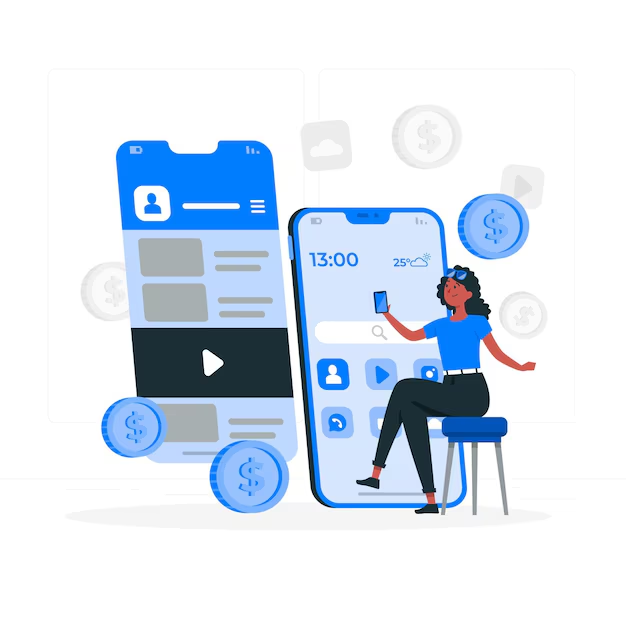All types of enterprises are fundamentally driven by the desire to make money. The market for mobile apps is the same. Businesses that use apps look to create revenue streams to make a profit and recover their investment. Monetizing mobile apps is how this is accomplished.
Making money from an app by utilizing its user base is known as mobile app monetization. App creators have a variety of options for utilizing their user base. There are countless ways to monetize an app, including posting adverts, selling goods inside, and providing subscription services.
This blog explains mobile app monetization and the different strategies and channels you can use. Whether you’re using a free online app maker or working with the best mobile app development company in the USA. They convert a WordPress site to an Android app or use any other method to create an app. Thus, it’s important to read this blog carefully. Let’s get dive!
Top 5 App Monetization Models and Strategies
Paid Downloads
The graph shows that most paid apps cost less than $5. This data is from the Google Play Store. Statista found that the average cost of a paid app in the Apple App Store is $4.37. Although this is a bit higher than in the Google Play Store, it’s still under $5.
You have the choice to choose your own prices for your app. However, if you’re planning on charging people for downloads, it needs to be within the price range they’re accustomed to. Pay-to-download has disadvantages, even though it’s a fairly simple monetization strategy. You shouldn’t anticipate nearly as many downloads as you would with a free app. If an app isn’t free, some users won’t even think about installing it.
That being said, there’s a greater chance that paying users will be very involved. Those who purchase a download will wish to maximize their return on investment. With various app monetization techniques on our list, you could get even more money from those users if they are regular app users.
In-App Purchases
Both paid and free applications can make money with in-app purchases. This approach can be applied to both virtual and tangible goods.
The in-app purchase system is a favorite tool for gaming apps to get virtual currency or experience enhancements. In a mobile game app, players may have to pay real money to access new vehicles, weaponry, maps, or other features.
This also includes purchases made through your app by customers of shirts, shoes, books, watches, and other items you offer online. It makes perfect sense for someone who already sells real or digital goods online to use an app to generate income.
Subscriptions
An app’s subscription feature is great for bringing in recurring income. You may easily set up a subscription business plan with your software through the Google Play Store and the Apple Software Store. Customers just need to create a subscription once, after which they will be billed automatically until they explicitly cancel it.
Subscription applications are often billed on a monthly schedule. However, quarterly or annual billing cycles can also be established. As the preceding example illustrates, giving longer subscription terms and better monthly pricing is customary. There are many possible businesses and use cases for subscription applications.
Freemium Model
The freemium app model combines elements of both subscriptions and in-app purchases. It’s worth mentioning on its own because it’s a bit different from the others.
“Freemium” comes from blending “free” and “premium.” So, you initially offer your app for free, which is the first step in this strategy. Then, you provide different versions of the app—one free and another premium.
With freemium apps, the free version must still be valuable. For instance, if Pandora’s free version only played one minute of each song, it wouldn’t attract many users, making it hard to convert them to paid subscribers.
Additionally, ensure that the premium features offer real value. Users may not see a reason to upgrade if the difference between the free and premium versions is minimal.
Advertisements
One very common method of app monetization is ad income. Using this technique, you charge for ad space inside your software. Some of you may be familiar with this model if you run advertisements on your website.
The best way to monetize apps is through mobile advertising, per a recent poll of the biggest app publishers worldwide. App advertising is available in a wide range of forms and dimensions. Within this category, there are not only many ad forms (such as pop-ups, interstitials, videos, banners, and native ads) but also various income models:
- CPC (cost-per-click)
- CPI (cost-per-install)
- CPA (cost-per-action)
- CPM (cost-per-mile)
- CPV (cost-per-view)
Even though in-app purchases are common and lucrative, not everyone fits them well. Ads may occasionally detract from the user experience and, in the end, reduce the appeal of your app. Therefore, you should think about this before haphazardly including advertisements in your app.
Conclusion
Monetizing an app can be challenging for developers and business owners, but it doesn’t have to be complicated. Start by learning about the various methods to generate revenue from your app, and then determine which ones suit your needs best. This guide provides all the essential information on app monetization, so use it as a valuable resource throughout the process.




